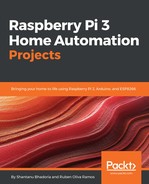Building your own board for a specific Internet of Things project has many advantages. Well, first, it means that you don’t end up with an ugly breadboard with wires going everywhere. This also adds a layer of safety and reliability to your project, as no wire can get disconnected during the use of the project. Finally, it means that if your board is also interesting for other people, you already have a project that’s nearly ready for production and reselling.
The board itself has several digital and analog I/Os as well as an onboard Wi-Fi chip and processor. But that’s not all: by default, the Photon board connects automatically to the Particle platform, which is an online cloud platform from which you can control your board. Therefore, you don’t have to find a cloud platform provider for the project; it’s all done for you automatically.
Now, an important thing at this point is to make sure your Photon is updated to the latest version. The one I received had an old firmware on it, and I just couldn’t program it from the web IDE. To do that, I recommend that you use the Particle CLI tool. Install it from https://github.com/spark/particle-cli.
You also need to put your Photon in the DFU mode. To do that, simply hold both buttons on the board and then release the reset button first. The Photon LED should be blinking yellow.
Finally, download the firmware and get the required instructions from https://github.com/spark/firmware/releases.
In this project, we are going to use the Particle Photon board itself but in the version that comes without the headers. With this version, we’ll be able to integrate it into a PCB design.
